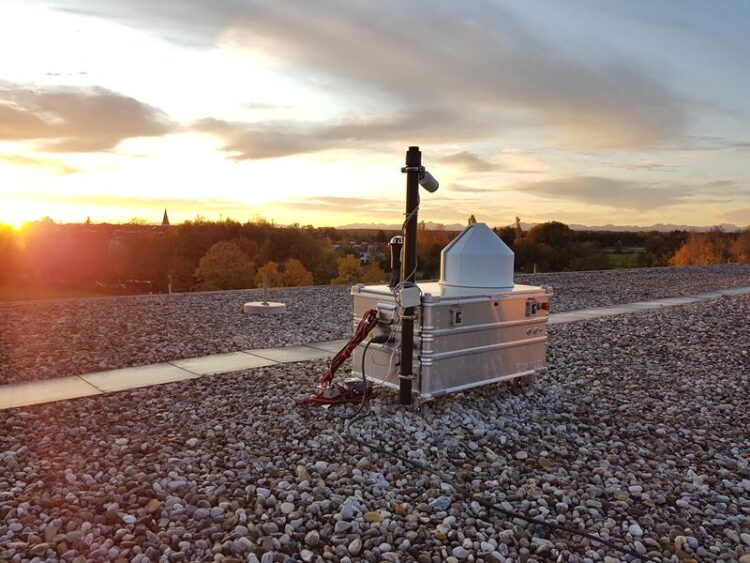Precision technology allows quantification of urban greenhouse gas emissions

Measuring device of the MUCCnet sensor network set up by Prof. Jia Chen, Chair of Environmental Sensing and Modeling, at the Technical University of Munich on the roof of a building in Taufkirchen.
F. Dietrich / TUM
Munich is home to the world’s first fully automated sensor network for measuring urban greenhouse gas emissions based on ground-based remote sensing of the atmosphere. It has been developed by scientists in the group of Jia Chen, Professor of Environmental Sensing and Modeling at the Technical University of Munich (TUM). Now, anyone can view the measurement data via an Internet platform.
The sensor network MUCCnet (Munich Urban Carbon Column network) consists of five high-precision optical instruments that analyze the sun’s light spectra. They measure the concentration of the gases carbon dioxide (CO2), methane (CH4) and carbon monoxide (CO). Since each gas has its own unique spectral “fingerprint”, concentrations of these gases can be determined in the columns of air between the instruments and the sun.
“By measuring a vertical column of the atmosphere, local disturbances, such as the disproportionate influence of neighboring stacks, can be removed. Therefore, this type of greenhouse gas balancing is considered particularly robust and accurate,” says Prof. Jia Chen.
Measurements at five locations in and around Munich
One of MUCCnet’s measurement devices is located on the main campus of TUM and measures inner-city concentrations. Four other devices are located at the Munich city borders in all four cardinal directions (north: Oberschleissheim, east: Feldkirchen, south: Taufkirchen and west: Graefelfing).
Chen explains the principle in simple terms: “We set up one sensor upwind from the city and the second downwind. So any increase in gases between the first sensor and the second must have been generated from inside the city.” To cover as many wind directions as possible, there is a sensor in each cardinal direction. With the input of the sensor data and meteorological parameters, high-performance computers can create a spatially resolved emission map of the city.
Using measured data to improve the calculated emission figures
Under the Paris Climate Agreement, atmospheric measurements are not required to meet emissions targets. “Instead, the emissions numbers we hear in the news are based on calculations,” explains Prof. Chen.
Among other things, this makes it impossible to detect so far unknown sources – such as leaks in gas pipelines. Therefore, Prof. Jia Chen’s team and project leader Florian Dietrich created MUCCnet to measure emissions with high precision, which can reduce inaccuracies in calculations.
Corona lockdown as a natural experiment for the measurement data series
The current Corona crisis provides a useful natural experiment for researchers because as a result of the two German lockdowns in spring 2020 as well as winter 2020/21 and severe air traffic curtailment, there have been changes in urban greenhouse gas emissions, which can be used to validate measurements as well as atmospheric transport models.
Unfortunately, the lifetime of CO2 is very long (several hundred years) and measurement results show that even such a drastic global event as this pandemic has not stopped the annual increase of CO2 concentration in the atmosphere.
Measurement data can be accessed online
Since the start of 2021, the researchers have operated a website (http://atmosphere.ei.tum.de) which not only makes measurement data available to everyone, but also explains the devices used and the principles employed to gain the data. Interested parties can find absolute values of greenhouse gas concentrations on the portal and can, for example, draw comparisons between stations at different locations.
“Since climate change is a global problem, the Munich network should only be the first step,” says Prof. Chen. In the future, Chen’s team plans to use measurements from existing greenhouse gas satellites to expand the methods and models developed in Munich worldwide and thus make a decisive contribution to understanding and solving the climate problem.
Wissenschaftliche Ansprechpartner:
Prof. Dr.-Ing. Jia Chen
Technical University of Munich
Department of Electrical and Computer Engineering
Professorship of Environmental Sensing and Modeling
Theresienstr. 90 (0105)/I
80333 Munich
Germany
Phone: +49 (0)89 289 23350
e-Mail: jia.chen@tum.de
Twitter ID: @JiaChenTUM
https://www.linkedin.com/in/jia-chen-328a6917/
https://www.ei.tum.de/en/esm/home/
Originalpublikation:
Dietrich, F., Chen, J., Voggenreiter, B., Aigner, P., Nachtigall, N., and Reger, B.: MUCCnet: Munich Urban Carbon Column network, Atmos. Meas. Tech., 14, 1111–1126, https://doi.org/10.5194/amt-14-1111-2021, 2021.
Weitere Informationen:
https://mediatum.ub.tum.de/1600255 (high resolution images)
http://atmosphere.ei.tum.de (MUCCnet webpage)
https://www.ei.tum.de/en/esm/home/ (Professorship of Environmental Sensing and Modeling)
https://www.professoren.tum.de/en/chen-jia (Prof. Jia Chen)
https://www.tum.de/nc/en/about-tum/news/press-releases/details/36482/ (Press release)
https://doi.org/10.5194/amt-14-1111-2021 (Original publication)
Media Contact
All latest news from the category: Power and Electrical Engineering
This topic covers issues related to energy generation, conversion, transportation and consumption and how the industry is addressing the challenge of energy efficiency in general.
innovations-report provides in-depth and informative reports and articles on subjects ranging from wind energy, fuel cell technology, solar energy, geothermal energy, petroleum, gas, nuclear engineering, alternative energy and energy efficiency to fusion, hydrogen and superconductor technologies.
Newest articles

Parallel Paths: Understanding Malaria Resistance in Chimpanzees and Humans
The closest relatives of humans adapt genetically to habitats and infections Survival of the Fittest: Genetic Adaptations Uncovered in Chimpanzees Görlitz, 10.01.2025. Chimpanzees have genetic adaptations that help them survive…

You are What You Eat—Stanford Study Links Fiber to Anti-Cancer Gene Modulation
The Fiber Gap: A Growing Concern in American Diets Fiber is well known to be an important part of a healthy diet, yet less than 10% of Americans eat the minimum recommended…

Trust Your Gut—RNA-Protein Discovery for Better Immunity
HIRI researchers uncover control mechanisms of polysaccharide utilization in Bacteroides thetaiotaomicron. Researchers at the Helmholtz Institute for RNA-based Infection Research (HIRI) and the Julius-Maximilians-Universität (JMU) in Würzburg have identified a…



